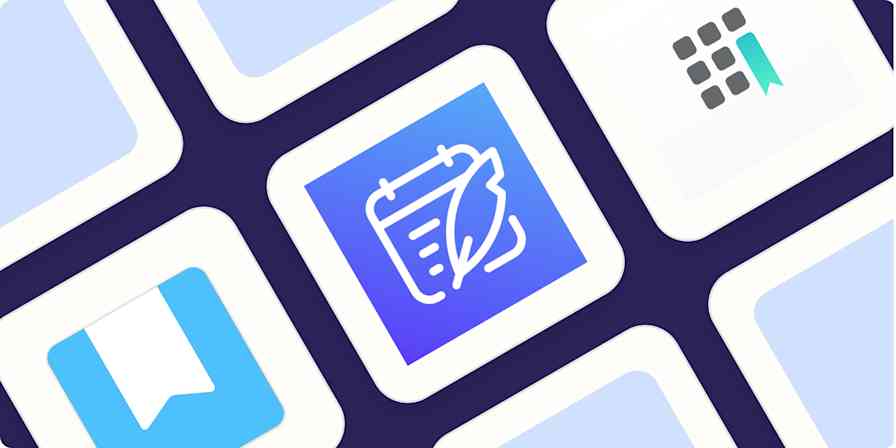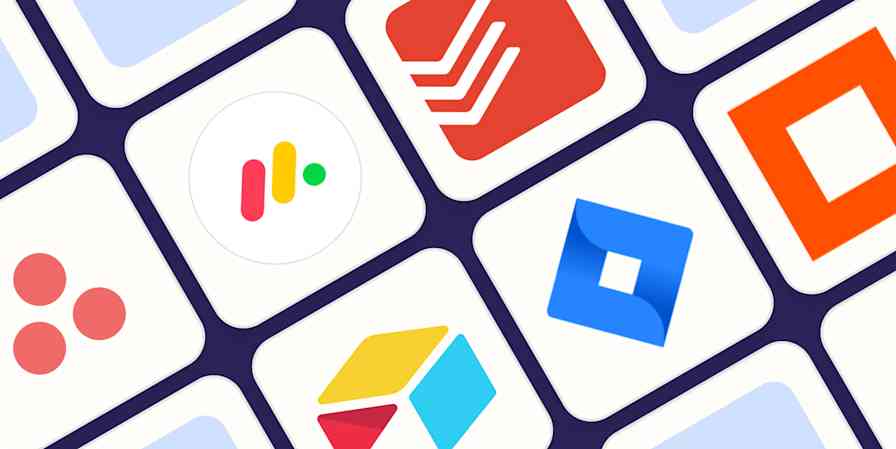How you organize your to-do list can make you more productive. You don't want to see your household shopping list while in the thick of office work, and you don't want to be reminded of an important presentation while you're grocery shopping on your day off. Working on the right tasks at the right time is a central tenet of the Getting Things Done® (GTD®) methodology, which is designed with productivity in mind. If you follow GTD or are thinking of adopting it, you need an app built to work with this unique system. While there are hundreds of to-do apps you could use, we tested more than 30 options to find the 10 best apps for GTD. These apps help you follow GTD and get more done.
Getting Things Done® and GTD® are registered trademarks of the David Allen Company.
What Is GTD?
GTD stands for Getting Things Done, which is both a book title and a method of working developed by David Allen. Getting Things Done contains both overarching theories about personal productivity as well as a step-by-step approach for organizing everything you need to do.
As mentioned, an important principle in GTD is to focus on the right tasks at the right time. Location words, such as "home" and "office" show up often on a GTD task list. Additionally, GTD encourages you to write down any tasks or ideas that pop into your mind quickly so you can get them out of your mind and save them for later without getting distracted from whatever you're doing in the moment. While the GTD method has a lot more to it and you can implement this with pen and paper, those two examples—using location words and writing down ideas quickly—are reasons an app designed for GTD is superior to using paper. Additionally, editing your tasks is easier and cleaner in an app than on paper, whether you're re-prioritizing items, re-assigning due dates, or changing your language to be more specific about what you need to get done.
See our overview of GTD for more about the methodology.
Some (including Allen) have argued that when you remember a task that you need to write down, it's faster to do it on paper than take out your phone, open an app, and tap the right buttons. But that's not necessarily the case when you sit in front of a computer all day long, or if you use speech-to-text dictation on your phone.
Being able to send a note from the email app that's already open on your desktop directly into your to-do app can save you time and prevent distractions that can come from looking at other ideas you've jotted down. Similarly, having a shortcut on your phone that opens a new task note in your GTD app where you can dictate an idea is anything but tedious. It's fast, efficient, and simple. Capabilities such as those are part of what make some GTD apps better than others.
A Note on Price: GTD apps are rarely free, and when a free tier of service is available, it's often quite limited. In this list of the best apps for GTD, only two have a free offering: NirvanaHQ and Todo by Appigo. Most charge either a recurring subscription fee, anywhere from $20 to $120 per year, or charge somewhere in the ballpark of a $50-one-time fee for a desktop app.
How We Choose the Best GTD Apps
How we evaluate and test apps
Our best apps roundups are written by humans who've spent much of their careers using, testing, and writing about software. Unless explicitly stated, we spend dozens of hours researching and testing apps, using each app as it's intended to be used and evaluating it against the criteria we set for the category. We're never paid for placement in our articles from any app or for links to any site—we value the trust readers put in us to offer authentic evaluations of the categories and apps we review. For more details on our process, read the full rundown of how we select apps to feature on the Zapier blog.
The apps on this list all meet three basic requirements. First, they have features that are specific to GTD, such as the ability to add context to tasks. Second, they're accessible on more than one platform, because it's important to be able to refer to your GTD list no matter where you are. (In a perfect world, we'd favor apps that are available on as many platforms as possible, but among GTD apps, some of the better ones are for macOS and iOS only.) Third, they have to be intuitive to use and well designed, so people will actually use them. That's something we determined through hands-on testing.
A little more on the first point: As many followers of GTD know, some apps are specifically designed for the method while others are flexible and can be used for it if you set them up for that purpose. For example, note-taking app Evernote wasn't designed specifically for Allen's method, but you can easily configure the settings and features to use Evernote for GTD. Nevertheless, we don't include apps of that nature here.
If you're looking for a task-management app with more flexibility, see also our recommendations of the 40 best to-do apps.
So, all that said, here, in alphabetical order, are the 10 best apps for GTD.
The Best Apps for GTD
2do
Best for adding specific details to tasks
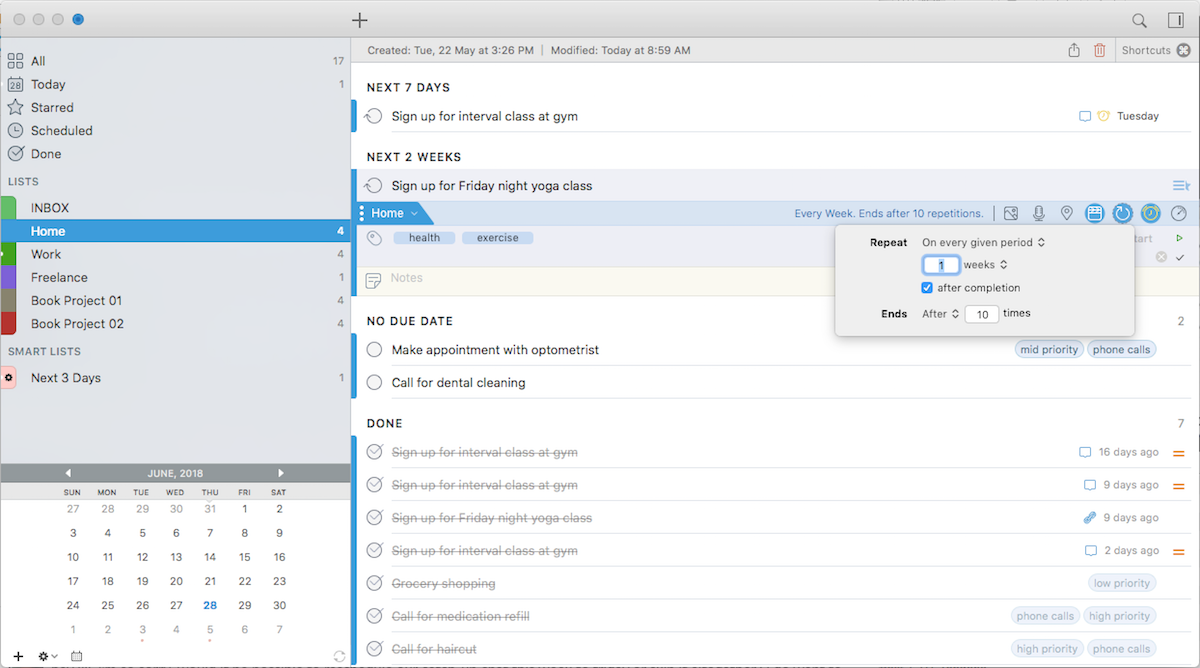
2do is a feature-rich app for GTD available for Mac and iOS devices only. One helpful feature for people who follow GTD is that 2do has built-in fields for adding specific details to your task, such as place for a phone number when your task involves making a call or sending a text. 2do supports audio memos, time estimates for tasks, a calendar view, and fine granularity for adding reminders. Every task can have a unique reminder at a certain time with a tone, pop-up message, or whatever else you customize for it. This reasonably priced app doesn't offer collaboration natively, but you can share lists when you sync it via Apple Reminders. It also doesn't let you create new tasks via email, unless you sync it via Toodledo and use the email option provided in that app.
Supported platforms: iOS, macOS
Price: $14.99 (iOS), $49.99 (Mac)
FacileThings
Best for capturing and reviewing ideas and tasks the GTD way
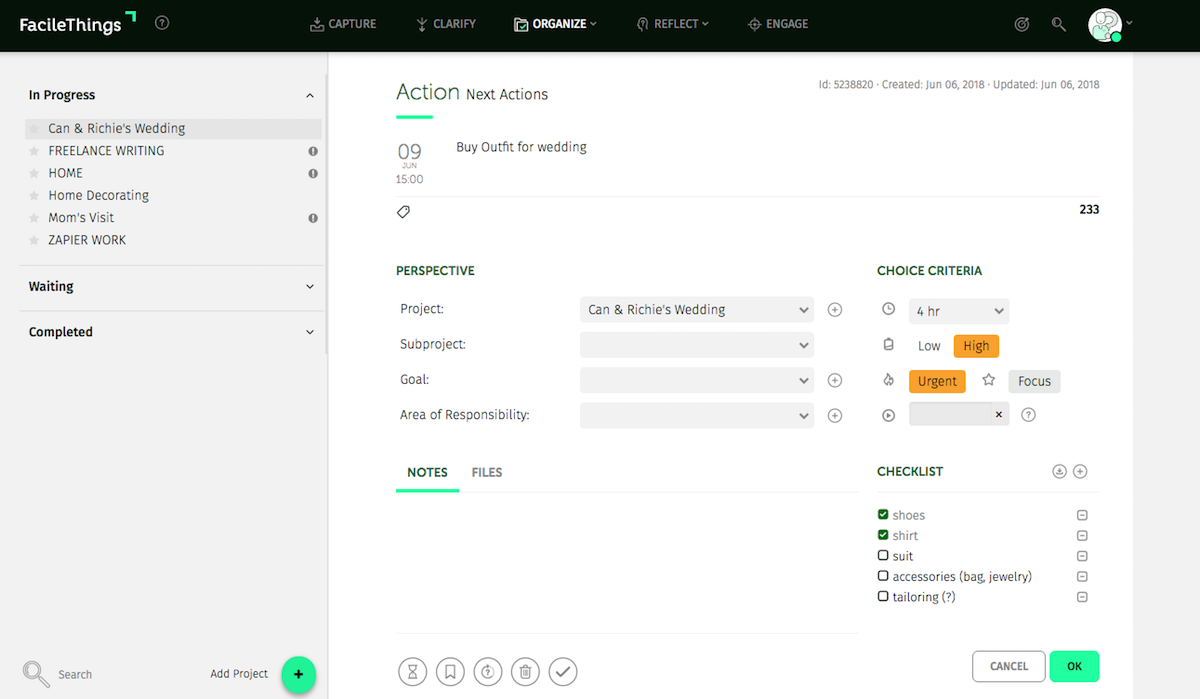
The web and mobile app FacileThings has a slick interface and uses several GTD-specific hooks to make it compelling. Its best feature is a two-step process called Capture and Clarify. You write down tasks quickly when they come to mind in a tab of the app called Capture, then when the time is right, you review them one by one in the Clarify section. It works very well for people who follow a strict GTD methodology, but it's not ideal if you like to add details to your tasks (such as deadline, urgency flag, estimated amount of time to complete) when they come to mind because you must wait until the Clarify step to do so. Overall, FacileThings is a very good app with a wealth of features, including the ability to add tasks via email, and an aesthetically pleasing design.
Supported platforms: Android, iOS, web
Price: $84/year
Firetask
Best for managing project-style work
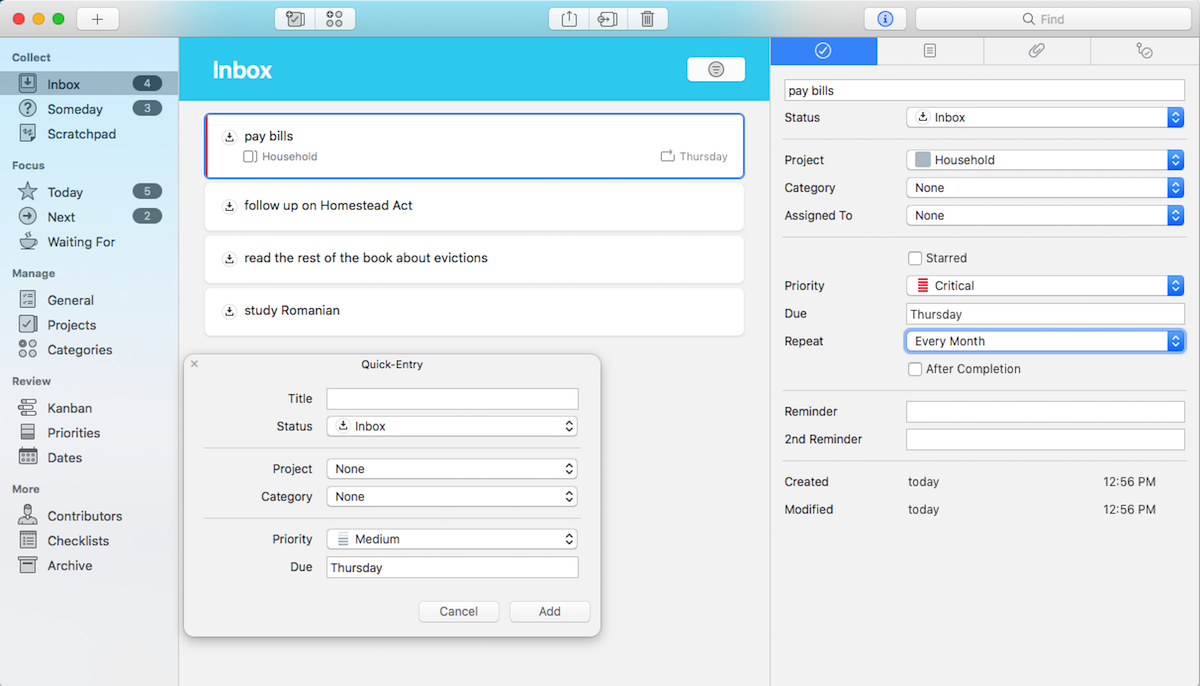
Firetask is a GTD app for Mac and iOS only that's well suited for people who have project-based work. Firetask includes an option to delegate tasks by assigning them to your contacts, though it doesn't offer true collaboration the way full-featured project management apps do. Other GTD features include views such as Today, showing all tasks that are due now or have been marked with a star, and Next for upcoming tasks and projects. Firetask also includes a kanban view of your tasks. The apps are sold separately for a reasonable one-time fee. Supported platforms: macOS, iOS
Price: $39.99 (Mac); $19.99 (iOS)
Focuster
Best for scheduling tasks
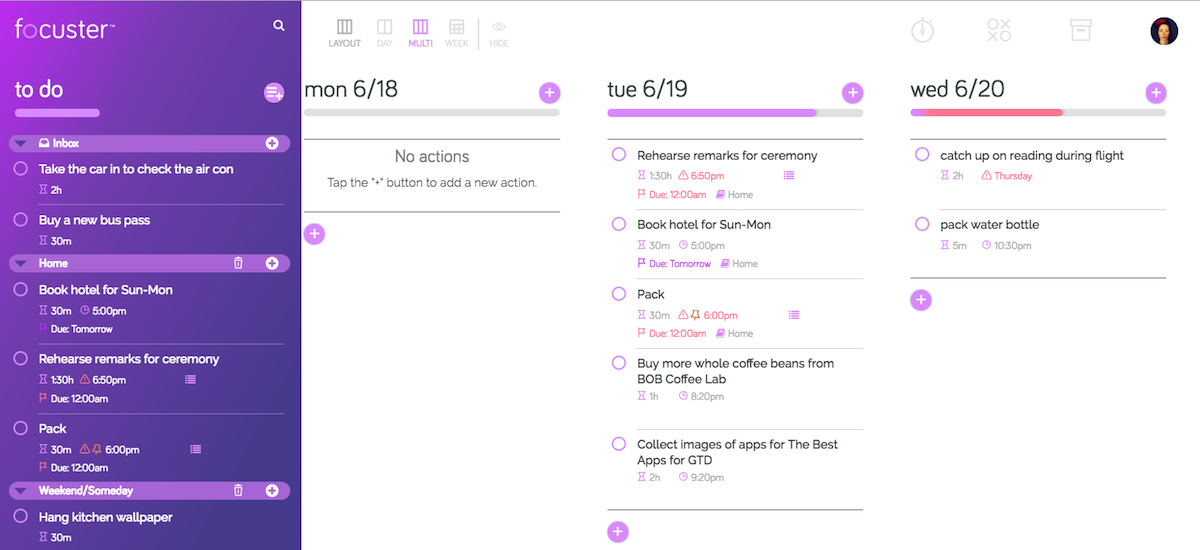
The web-app Focuster, which is also accessible on mobile browsers, was made for busy entrepreneurs who need help with time management. Its signature feature is that it automatically checks your Google Calendar for times when you're free and then schedules tasks accordingly. You tell Focuster when tasks are due and how long you expect them to take, in addition to your working hours and time off, and it takes care of the rest. Focuster does not offer the ability to create tasks by simply sending an email to a unique address, the way many other GTD apps do, but you can achieve the same thing through an integration with Zapier.
Supported platforms: web (including mobile browser)
Price: from $119.88/year
NirvanaHQ
Best for following GTD to a tee
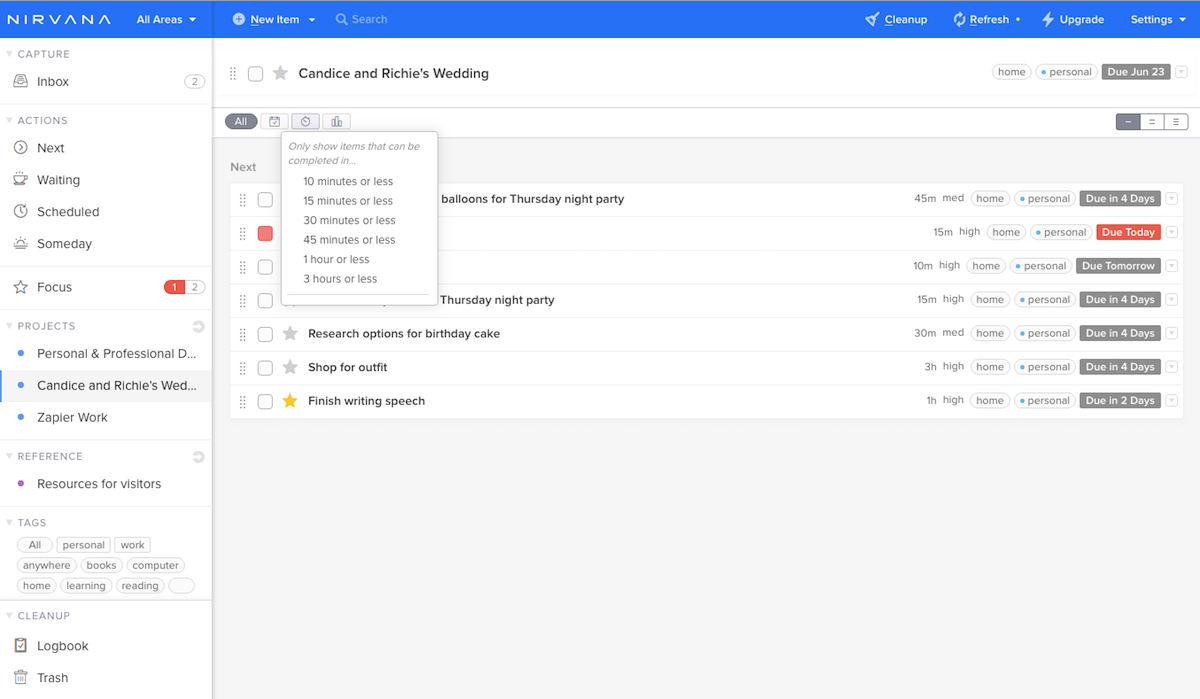
Designed with GTD in mind, task-management app NirvanaHQ comes preset with lists labeled Next, Waiting, Later, Scheduled, and Someday, plus an Inbox for capturing ideas on the fly. Nirvana has mobile apps for both Android and iOS, and a web app that supports plenty of keyboard shortcuts for when you're on a desktop. Each task can contain a time estimate, as well as an energy level estimate, so that you can easily find tasks that require low energy whenever you're starting to flag but still want to get things done.
Supported platforms: Android, iOS, web
Price: free with limitations; $5/month or $29/year for Pro; $49 flat fee for lifetime Pro
Nozbe
Best for use across a wide variety of platforms
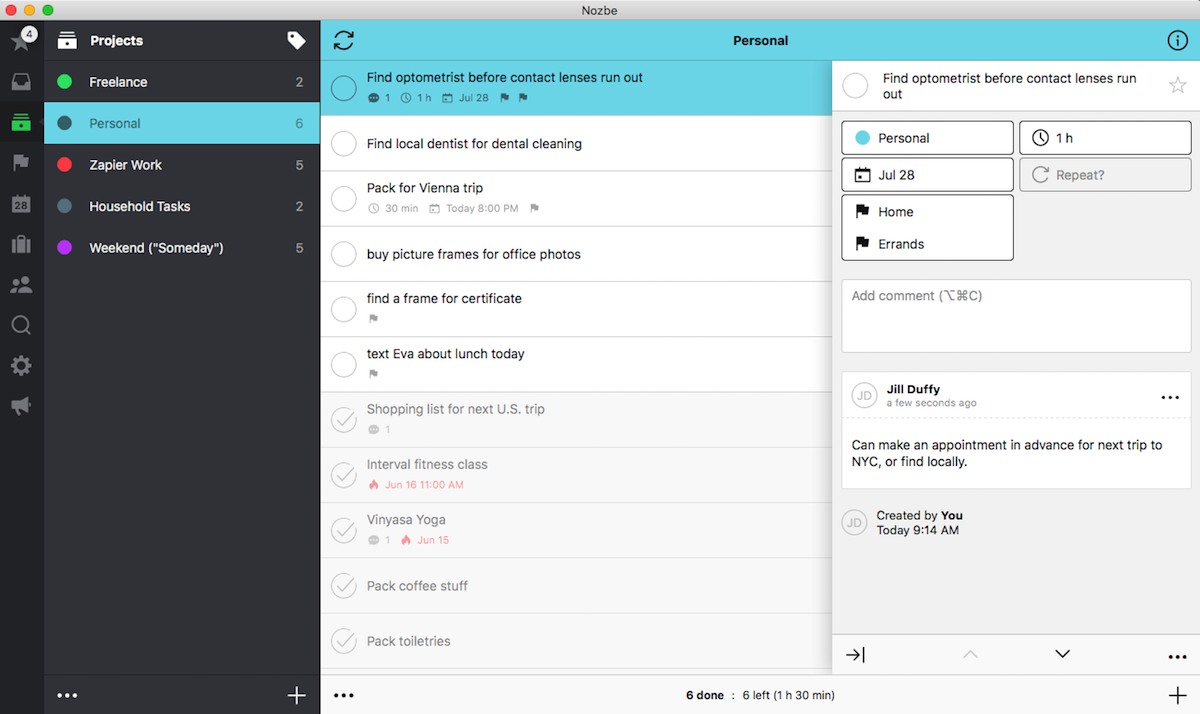
Some GTD app makers spin out a version for macOS and another for iOS, then call it a day. Nozbe, however, also has apps for Windows, Android, Linux, Apple Watch, and the web. It supports collaboration, with tiers of service for individuals, small teams, and businesses. Unlike many other GTD apps, Nozbe also offers a free tier of service that has an active project limit of five.
Supported platforms: Android, iOS, Linux, macOS, web, Windows
Price: $96/year
OmniFocus 3
Best for forecasting availability in a calendar view
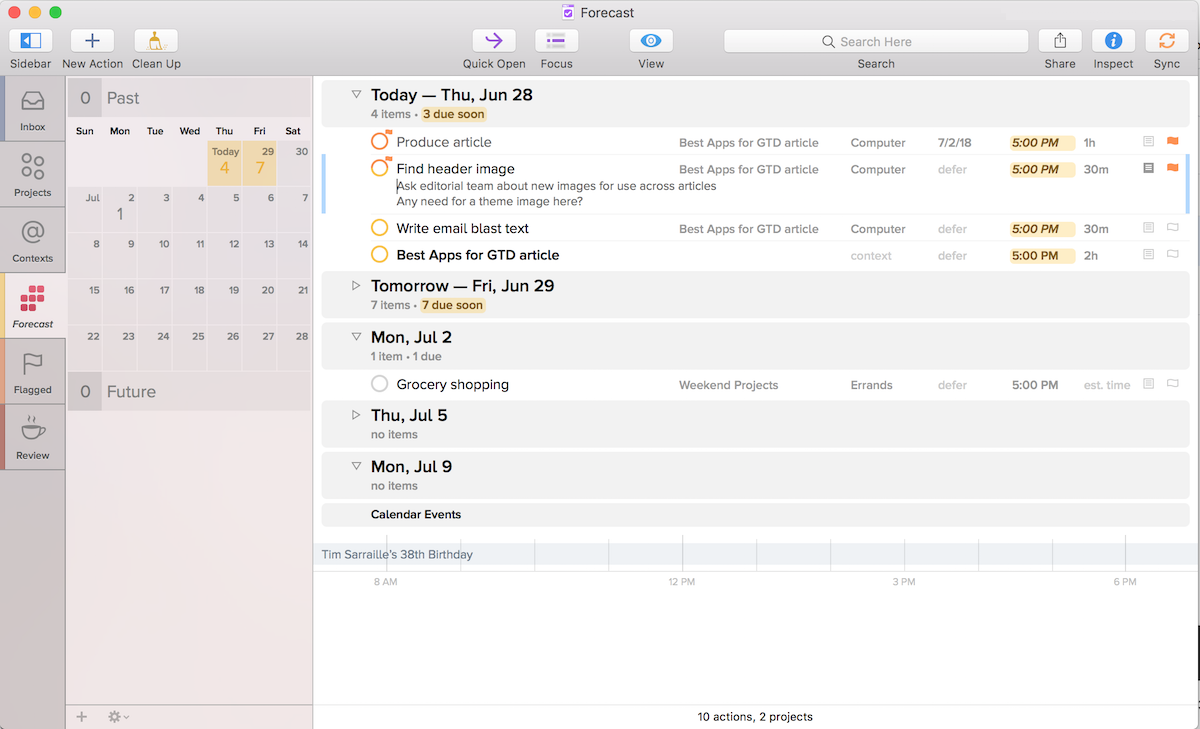
OmniFocus, now in version 3 for iOS and with a new Mac app coming September 2018, is a straightforward and powerful task-management app that's setup for GTD. It has features and functionality you'd expect, such as different areas for collecting new ideas (Inbox), organizing your todos (Projects), seeing what's relevant at the appropriate time (Context), and so forth. It's better for managing project work than one-off todos, although you're not limited from doing both. OmniFocus has a calendar view that you can use to forecast your best availability when scheduling new tasks. OmniFocus belongs to a suite of other apps for planning, outlining, and creating graphics, making it a good option for anyone who's also shopping for other productivity apps.
Supported platforms: iOS, macOS
Price: $39.99 for Mac app or $79.99 for Pro; iOS app an additional $39.99 or $59.99 for Pro
Things 3
Best for visualizing progress
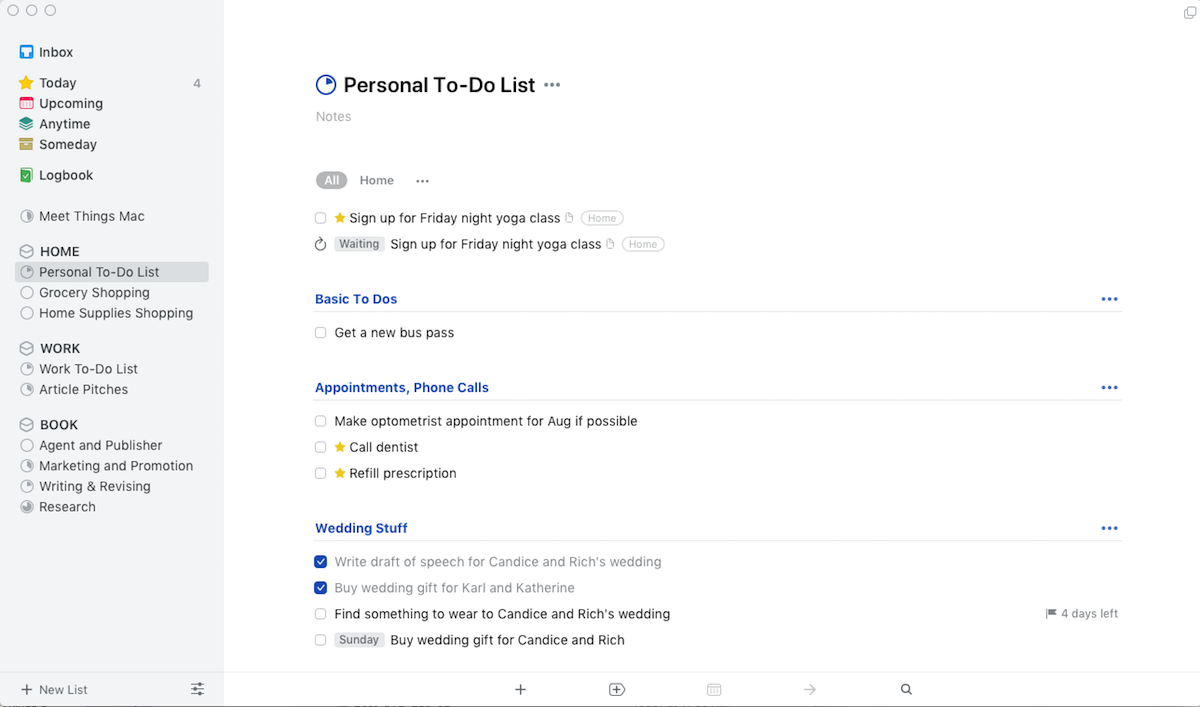
Things 3 is another straightforward GTD app, with an Inbox for collecting ideas and tasks as they come to mind, and sections that show you relevant tasks for the moment, such as Today and Upcoming. What makes Things shine, however, is its attention to detail. Being able to create headings within lists to group or separate items, for example, makes it easier to assess your tasks at a glance. The airy design of the calendar view, too, makes the app easy to read rather than cluttered looking. It also has a small graphic showing your progress toward completion for projects, a little circle graph that fills in as you check off related tasks. Things 3 is among the best GTD apps for its balance of design and features, though it's only available for Mac and iOS devices.
Supported platforms: iOS, macOS
Price: $9.99 (iOS), $49.99 (Mac)
Todo (by Appigo)
Best for offering a free tier of service
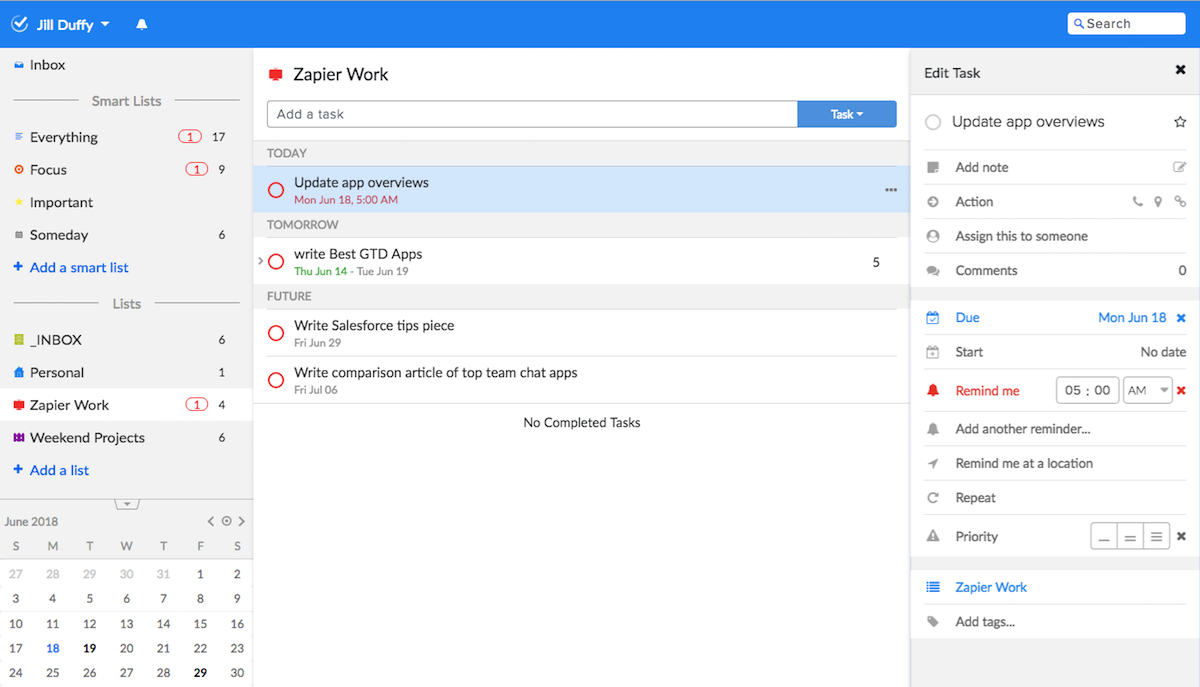
The GTD app simply called Todo has three tiers of service: Basic, Cloud, and For Business. The Basic app is free to use, and seeing as free is a rarity in this app category, it makes Todo attractive to anyone who wants the option to use it indefinitely without paying. A clear interface puts GTD-themed Smart Lists, such as Someday and Focus, into a left-side rail, along with your custom lists and a mini calendar. While the free Basic level works very well, its primary limitation is that it doesn't sync across other devices. For that, you'll have to pay a reasonable $19.99/year.
Supported platforms: Android, iOS, macOS, web, Windows
Price: free for Todo Basic; $19.99/year for Todo Cloud; $39.99/year for Todo For Business
Zendone
Best for organizing information into Tickler folders
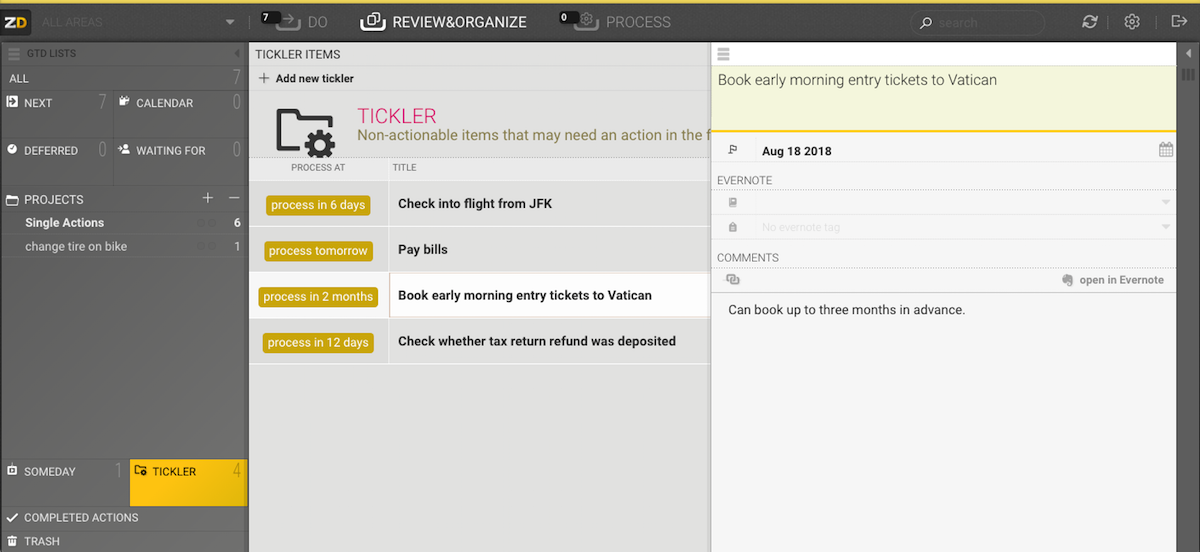
Although Zendone takes a little time to learn to use properly, it's a powerful GTD app once you get the hang of it. It's also the only GTD app I've seen to include Tickler folders, used for organizing items you need on particular days, such as airline tickets (or in the digital age, confirmation numbers and a link to a mobile boarding pass) and bills to pay. Similar to other GTD apps, Zendone gives you different sections for writing down, reviewing, and processing your tasks and thoughts. It has plenty of other GTD features, too, for tagging items by context, adding a time estimate, and indicating how much energy the task requires. While Zendone does not support task creation via email natively, you can enable it through an integration with Evernote.
Supported platforms: Android, iOS, macOS, web
Price: $60/year
GTD has a lot to offer, but it isn't for everyone. If it doesn't sound right for you, try exploring some other work methodologies designed for productivity until something clicks with you.
Alternatively, you can always borrow the parts of GTD that do sound up your alley and find a more flexible tool that lets you carry out the system in your own style. For example, we've found that using kanban apps for GTD can offer a rewarding experience, especially to people who enjoy organizing their tasks visually.
Keep Reading:
Top image by Freepik.



